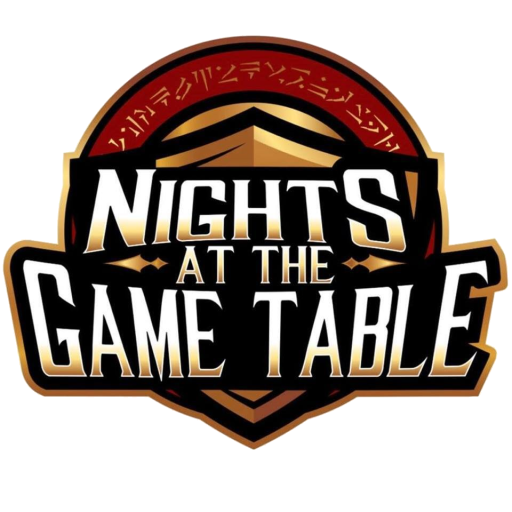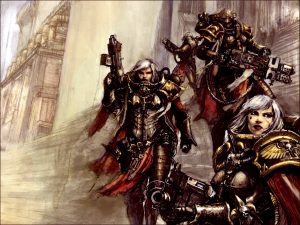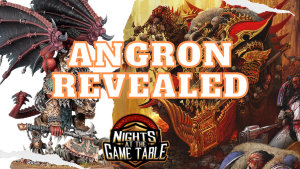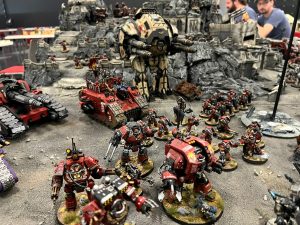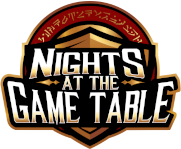Hey guys! Matt Root here. Welcome to another of my articles, Matt’s Root Cause Analysis, where I look at competitive lists and tell you what you need to know about GT winning lists!
Today, we’re going to talk about the boogeyman in the closet: the Psychic Plaguebearer Soup (which I will affectionately refer to as the PPS from now on). This is the list made famous by TJ Lannigan and Jim Vesal, who have piloted it to numerous GT wins within the last few months.
| Nurgle Daemon Battalion | |
| Poxbringer | 70 |
| Sloppity Bilepiper | 60 |
| 3 Nurglings | 54 |
| 30 Plaguebearers- Icon, Instrument | 235 |
| 30 Plaguebearers- Icon, Instrument | 235 |
| Daemon Battalion | |
| Changecaster | 65 |
| Daemon Prince- axe <khorne> | 180 |
| 15 Bloodletters- icon, instrument | 130 |
| 25 Pink Horrors | 175 |
| 10 Brimstones | 30 |
| TS Supreme Command | |
| Ahriman | 131 |
| Prince- wings, talons | 180 |
| Prince- wings, talons (WL) | 180 |
| Sorcerer- termie armor, familiar | 122 |
| Hellforged Contemptor Dread- C Beam Cannons | 148 |
| Reinforcement Points | 5 |
Strengths:
PPS was made with one goal in mind: to win ITC format missions. It does this exceptionally well. Keep in mind the goals of ITC format: Holding objectives and killing things every turn. PPS was tailored in mind to not only accomplish these goals every turn, but to also AVOID allowing the opponent to obtain these goals.

The jist of the army is essentially thus: You have a wall of 60ish plaguebearers backed by character support. Character support comes in the form of daemon characters (to make the Plaguebearers more resilient) and Thousand Son psykers, who perform the killing part of the list. This part of the list is essentially identical from iteration to iteration, with some variances taken from there on out.
The Plaguebearers are there to do two things: control the board and not die. By taking two units of 30, they come with an innate -1 to hit. They can be further buffed by psychic powers to be -2 to hit (on one unit), and the army can spend CP to give one of the units a 4+ invul. They almost always take an icon, which allows them to autopass morale on a 1 and generate more bodies. These plaguebearers then march up the board, sit on objectives (with objective secured) and prevent the opponent from shooting the easier-to-kill thousand son psykers and characters in the back. This allows the army to 1) Hold more objectives than the opponent and 2) Prevent the opponent from reliably getting “Kill more” each turn.

The Thousand Son Psykers are usually Ahriman with Daemon Princes with wings (occasionally with other psykers). These guys have incredible flexibility: Ahriman usually sits in the back and offers buffs, but the DPs can also serve as brutal counter assault units against things that charge the plaguebearers. They can smite at 24”, and since this is mortal wounds, the only way to protect against it is just by offering a ton of wounds to sacrifice to the smite bomb. Furthermore, since they are all characters, they can’t be shot behind the plaguebearer wall. This is where the majority of killing happens in the list, and where the army gets a Kill every turn in the ITC format.
The army hinges on this: hard to kill troops in the front, cannot-be-targeted-but-damaging characters in the back. The remainder of the army can differ.
Some alternative lists utilize Blightlord Terminators. As another brutal unit that is hard to kill, it can make use of the plague of flies stratagem to hide like the characters do. It’s a rock that can sit on an objectives, or counter charge. It can even serve as a back-up screen to the plaguebearers.
Foul Blightspawn are cheap characters with brutal flamers that do a flat 3 damage per wound. They serve as excellent anti-flyer units.

Horrors are the one reliably shooty unit in the army. They can deep strike down and metaphorically hose the opponent with shots, which is something the army otherwise lacks. This is made more brutal by a Changecaster casting flickering fire to further buff the ability of the shooting to do damage.
Poxbringers and Sloppity Bilepipers are some of the most important characters in the army. Poxbringers provide the coveted -1 to hit power on a plaguebearer unit. The Sloppity Bilepiper makes morale MUCH less of an issue by allowing the plaguebearers to roll 2d6 and discard the highest when rolling morale, making the army that much more reliable at gaining plaguebearers back due to the icon.
Sometimes you will see the Bloodletter bomb unit as a nice form of missile that can land and charge 3d6 to unload loads of wounds in close combat.

Finally, you will also see the occasional Hellforged Contemptor, usually with C-Beams. This dudes sits in the back, shoots a small horde unit and does 4d6 str 6 wounds for little to no investment, earning the player a (almost) free kill on turn 1 as the army advances up the field to get into position.
The thing about PPS is that it is strong at ITC format. Think about ITC secondaries for a moment: which would you pick?
There are a ton of characters for Headhunter, but they can hide behind the wall of plaguebearers. The only character that qualifies for Kingslayer is maybe the warlord, and he has the exact same issue as above. Marked for Death and Reaper both require you to kill the obnoxiously stupidly hard to kill plaguebearers. There are no targets for Gang Busters, Titan Slayers. Big Game hunter has the same issue as headhunter: it relies on killing characters. Ground control and King of the Hill just aren’t going to happen….
….You get the idea.

Weaknesses:
Frankly, not many.
This army was designed to win ITC missions. For that reason, it’s a tough nut to crack, especially when run by competent generals such as Jim Vesal and TJ Lannigan.
PPS is well rounded – and for that reason, it doesn’t have any one particular weakness, but similarly, it doesn’t really excel at one thing either. Unlike a pure Knights list, which you can either straight up handle or NOT handle, every list is CAPABLE of beating PPS – it’s just exceptionally hard.
Ironically, the weakness of PPS is similar to the weakness of the prior-to-nerf Castellan: It’s too damn good and too damn popular. You are going to be seeing a lot more of this list in the future. So, similar to what happened to the Castellan, people are going to start building specifically to counter it.
So what counters it? Character assassins, such as Vindicares, can punk the psykers. Anti-psyker units like the Infernal Enraptruss really mess with the army. Because the army really likes to blob, it is hugely susceptible to stratagems in the “3d3 mortal wound in a small area” category. And so on.
Basically, the list doesn’t really have weaknesses – until people start building specifically to counter it.

Tricks to be careful of:
Oftentimes, if the player takes a horror unit, he will leave a couple points off his list. This is so that if (and when) he deep strikes his horror unit, and he attempts to charge a shooty unit, if you overwatch, you kill a pink horror – which then splits into a blue horror or brimstone. Which can be placed in coherency, 2” in front of the charging unit. Which means a 6” or 7” charge instead of a 9” charge. Oops. So be careful about overwatching this unit.
Remember that plaguebearers determine if they have enough models (greater than 20) to get the -1 per phase. Meaning if the unit starts at -1 to be shot because it has 21 models in the shooting phase, it’s still going to be -1 to be shot for the rest of the shooting phase, regardless of how many more you kill.

How to beat it:
PPS can easily dictate the flow of a battle, so you have to bait your opponent into making mistakes and, more importantly, take advantage of them. For example, if the PPS general leaves his plaguebearer screen in a way where he doesn’t have a double layer protecting his characters, shoot it out (if you can) to get to the characters behind.
Another option is to try and force the PPS player to commit. If he has to move his daemon princes and other characters forward to counter charge a unit that smacks the plaguebearers (that he can’t smite to death), it allows you an opportunity to target them. Bait him into committing by sacrificing non-key units.
Watch the mission. More than other armies, you have to keep a close eye on which units you sacrifice to win the “hold more, kill more” aspect of ITC. For this reason, it’s not a bad idea to go second so you know exactly how much you have to beat the opponent by.

Watch your placement. The main weakness of smite (which this army relies heavily on) is that it has to target the closest unit. For that reason, shove unimportant, cheap units with lots of bodies in the front to absorb the smites: i.e., a boy squad or a conscript unit.
Use a chess clock. I’m serious. Good players like TJ lannigan and Jim Vesal won’t (often) run out of time, but there are a lot of intricate moves that require very precise placement in the PPS. An inexperienced PPS player can easily run out the clock, so keep them honest and make sure they’re using only their fair share of the time. It always feels bad to lose a game that only went to turn 2 or 3.
Pray to the dice gods. Hey, why the hell not?
Hope this helps guys! As always, this is Matt Root as part of Nights PRO to provide you with list breakdowns and tactics. If you’re looking for more info, all you do is contact me or Nick Nanavati on facebook or check out our facebook page.
See you next time on Matt’s Root Cause Analysis!
As always, A big thanks to Games Workshop for the images provided for this article.
